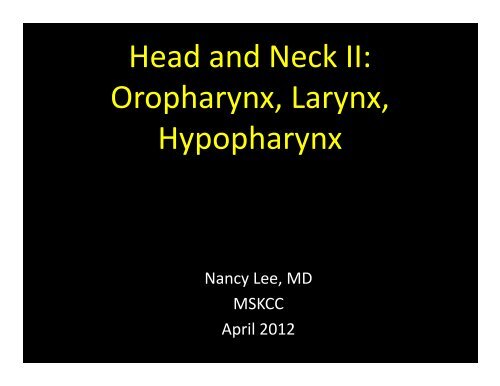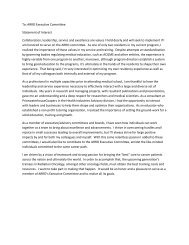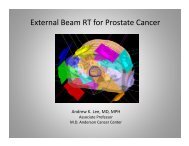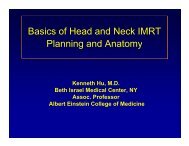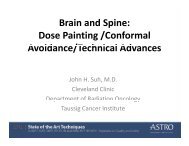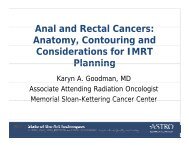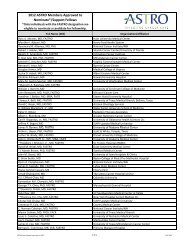Nancy Lee, MD - ASTRO
Nancy Lee, MD - ASTRO
Nancy Lee, MD - ASTRO
Create successful ePaper yourself
Turn your PDF publications into a flip-book with our unique Google optimized e-Paper software.
Head and Neck II:<br />
Oropharynx, Larynx,<br />
Hypopharynx<br />
<strong>Nancy</strong> <strong>Lee</strong>, <strong>MD</strong><br />
MSKCC<br />
April 2012
• Hi Historical t i l ddata t<br />
Outline<br />
• Toxicity as a result of non-surgical treatment<br />
• Use of IMRT for oropharyngeal cancer<br />
• Emergence of HPV related tumors
OROPHARYNX-Sites<br />
Base of tongue<br />
Soft palate<br />
Tonsillar fossa<br />
Anterior tonsillar pillars (palatoglossus muscle)<br />
Posterior tonsillar pillars p (palatopharyngeal (p p y g m.) )<br />
Glosso-tonsillar sulci<br />
Uvula<br />
Posterior oropharyngeal wall<br />
Vll Vallecula<br />
l
MR staging also T3N0.
INCIDENCE OF LYMPH NODE<br />
METASTASES ON PRESENTATION<br />
Base of Tongue 78%<br />
Tonsil & Tonsillar Fossa 76%<br />
Oropharyngeal Wall 59%<br />
Anterior Pillar 45%<br />
Soft Palate 44%
CA. OF THE OROPHARYNX<br />
INCIDENCE OF CONTRALATERAL<br />
OR BILATERAL NODES<br />
Base of Tongue 30%<br />
Soft Palate 16%<br />
Tonsil & Tonsillar Fossa 11%<br />
AAnterior i Pill Pillar 5%
CA. OF THE OROPHARYNX<br />
INCIDENCE OF OCCULT NODES<br />
Base of Tongue 50-60%<br />
Tonsil & Tonsillar Fossa 50-60%<br />
Soft Palate 20-30%<br />
Anterior Pillar 10-15%
Oropharyngeal CA:Treatment Volume<br />
(Nathu et al. Univ of Florida, 2000)<br />
• 1983-1985; N=114; T2-4 SCC Tonsil Tonsil, BOT BOT, Soft Palate<br />
• Definitive RT+/- brachy; 12 pts had induction chemo<br />
• Dose ranged from 50.4 50 4 to 81.6 81 6 Gy / 1.2 1 2 Gy BID +/- +/ 10 10-<br />
15 Gy of brachy boost; 16 pts had QD RT with median<br />
dose of 70 Gy<br />
• All had pretx CT scan to determine volume and<br />
subsequently q y underwent CT tx planning p g<br />
• Multivariate analysis showed that local control rate<br />
correlated with T-stage but did not correlate with<br />
tumor volume within a given T-stage
Oropharyngeal CA: Treatment Volume<br />
(Hermans et al. Belgium, 2001)<br />
• Investigate the value of CT CT-derived derived tumor parameters<br />
as predictor of local and regional outcome of tonsillar<br />
squamous cell carcinoma treated by definitive RT<br />
• N=112 from 1987-1998<br />
• Median follow up p was 33 months<br />
• Primary volume did not predict local control within the<br />
T2, T3, and T4 category<br />
• Total tumor volume was not significantly related to LC<br />
• Multivariate analysis showed that T and N were the<br />
y<br />
independent predictors of LC
RTOG 73-03<br />
RT + Surgery for Head & Neck Carcinoma<br />
Oral Cavity<br />
Oropharynx<br />
Stage II-IV II IV<br />
S<br />
R Pre Pre-op op RT (50 Gy) +<br />
T Sex A<br />
surgery<br />
R<br />
A T-Stage<br />
T<br />
I<br />
F<br />
Y<br />
N<br />
D<br />
O<br />
M<br />
NN-Stage St I<br />
Z<br />
E<br />
Surgery g y+ Post-op p RT<br />
(60 Gy)<br />
RT alone (65-70 Gy) +<br />
surgical i lsalvage l
RTOG 73-03 Oral Cavity And Oropharynx<br />
Survival<br />
Treatment 4-Yr Survival<br />
Pre Pre-op op RT 30%<br />
(N=23/43)<br />
Post-op RT 36%<br />
(N=23/43)<br />
RT Alone 33%<br />
(N=24/43)<br />
p=0.81
RTOG 73-03 Oral Cavity and Oropharynx<br />
Local-Regional Control<br />
Treatment 4-Yr Local-Regional g<br />
Control<br />
Pre Pre-op op RT 43%<br />
(N=23/43)<br />
Post-op RT 52%<br />
(N=23/43)<br />
RT Alone 38%<br />
(N=23/43)<br />
p=0.42
Surgery and Adjuvant RT vs. CCRT in Stage III/IV<br />
Nonmetastatic SCC of head and neck :<br />
Randomized Comparison/Singapore, Soo et al.<br />
Stage III or IV of<br />
sq q cell ca<br />
Oral Cavity<br />
Oropharynx<br />
Larynx y<br />
Hypopharynx<br />
Max Sinus<br />
R<br />
A<br />
N<br />
D<br />
O<br />
M<br />
I<br />
Z<br />
E<br />
Surgery + RT<br />
(60 Gy to 70 Gy)<br />
Chemo + RT<br />
(CDDP+5FU (CDDP 5FU x 2) and 66 Gy<br />
Medium F/U : 6 Years
Surgery vs. Chemoradiotherapy<br />
Soo et al. Br J Cancer 2005; 93:279-286
Stage III/IV Head and Neck CA:<br />
Randomized Trial<br />
Soo et al, Br J Cancer 2005<br />
•No difference in 3-year disease-free survival rates<br />
(50% vs vs. 40%)<br />
•Surgical g complication p rate: 27%<br />
•Organ preservation rate overall is 45%<br />
•Larynx/hypopharynx had higher organ<br />
preservation of 68% versus 30%
BOT<br />
SCC of Oropharynx<br />
Parsons. Cancer 2002<br />
Surgery+/-RT g y<br />
RT +/- S<br />
LC 79% 76%<br />
LRC 60% 69%<br />
CSS 62% 63%<br />
Cx(Fatal) 32% (3.5%) 3.8% (0.4%)<br />
Tonsil<br />
LC 70% 68%<br />
LRC 65% 69%<br />
CSS 57% 59%<br />
Cx(Fatal) 23(3.2%) 6%(0.8%)
CA. OF THE TONSILLAR REGION<br />
LOCAL CONTROL BY XRT<br />
Institution T1 T2 T3 T4<br />
M. D. Anderson 100% 90% 72% 38%<br />
UU. of Florida 87% 79% 71% 44%<br />
M G H 81% 79% 60% 23%<br />
U. of Michigan 92% 77% 50% 25%<br />
Washington UU. 92% 72% 57% 30%
CA. OF THE TONSILLAR REGION<br />
SURVIVAL AFTER XRT<br />
Institution Survival<br />
MM. DD. Anderson 47 47.5% 5% (5 yr yr. Determinate)<br />
MGH 44% (3 yr. NED)<br />
Princess Margaret Hospital 38% (5 yr. Actuarial)<br />
54% (5 yr. DDeterminate) t i t )<br />
Washington g Universityy 40% % (5 ( yr. y Absolute) )
CARCINOMA OF THE TONSIL<br />
LOCAL CONTROL BY T-STAGE<br />
T1 83%<br />
T2 81%<br />
T3 74%<br />
T4 60%<br />
UNIVERSITY OF FLORIDA, JCO, 2000
CARCINOMA OF THE TONSIL<br />
5 YEAR CAUSE-SPECIFIC SURVIVAL<br />
STAGE I 100%<br />
STAGE II 86%<br />
STAGE III 82%<br />
STAGE IVA 83%<br />
STAGE IVB 22%
BASE OF TONGUE IMPLANTS<br />
Patient Selection Criteria<br />
• Tumor stage or extent<br />
• GGrowth<br />
pattern<br />
• Histology<br />
• Age<br />
• General medical condition<br />
• Availability of expertise and<br />
equipment<br />
i t
BASE OF TONGUE IMPLANTS<br />
Contraindications<br />
• Bone invasion<br />
• Persistent otalgia (nerve<br />
invasion)<br />
• Extension below the arytenoids<br />
• Anesthetic risk<br />
• Patient intolerance
BASE OF TONGUE IMPLANTS<br />
Dose to the Primary<br />
External Beam : 50.4 Gy<br />
Implant :<br />
T1 : 20 Gy<br />
T2 : 25 Gy<br />
T3 : 30 - 35 Gy<br />
T4 : 30 - 40 GGy
BASE OF TONGUE IMPLANTS<br />
Dose to the Nodes<br />
External Beam : 50.4 Gy<br />
Implant :<br />
N1 : 15 Gy<br />
N2 : 20 - 30 Gy<br />
N3 : 30 - 40 Gy
Trans-Tasman Radiation Oncology<br />
PPoulsen l et t al. l RRadiotherapy di th OOncology. l 2001<br />
• N = 350<br />
• 1991-1998<br />
• RRandomized d i dtrial i l<br />
• 14 centers in New Zealand<br />
• III/IV SCC of OC, oropharynx, hypopharynx, larynx<br />
• Conventional vs ACC<br />
• 70 Gy at 2 Gy per day versus 59.4 Gy at 1.8 Gy BID<br />
• Median F/U 53 months
Tans-Tasman Radiation Oncology Group<br />
(P (Poulsen. l RRadiotherapy di th and d OOncology. l 2001)<br />
5-year Results AFx CFx p<br />
LC 52% 47% 0.3<br />
DFS 35% 41% 0.23<br />
DSS 46% 40% 0.398<br />
Confluent<br />
MMucositis iti 94% 71%
RTOG 90-03<br />
PHASE III STUDY OF ALTERED FRACTIONATION VS VS.<br />
STANDARD FRACTIONATION FOR H & N Ca.<br />
S<br />
T<br />
R<br />
A<br />
Site<br />
R<br />
A<br />
Oral Cavity<br />
Oropharynx<br />
Larynx<br />
Hypopharynx<br />
yp p y<br />
N<br />
D<br />
1. Standard Fractionation<br />
2. Hyperfractionation<br />
T<br />
I<br />
Stage<br />
N0 vs N+<br />
O<br />
M<br />
3. Accelerated Fractionation<br />
(Split-Course)<br />
F<br />
Y<br />
KPS<br />
90-100 vs<br />
60 60-80 80<br />
I<br />
Z<br />
E<br />
4. Accelerated Fractionation<br />
(Concomitant Boost)
RTOG 90-03<br />
PHASE III STUDY OF ALTERED FRACTIONATION<br />
VS. STANDARD FRACTIONATION FOR H & N Ca.<br />
FRACTIONATION SCHEMES<br />
1. Standard Fractionation T.D.: 70.0 Gy/35 fx/7 wks<br />
2.0 Gy/fx Q.D.<br />
2. Hyperfractionation T.D.: 81.6 Gy/68 fx/7 wks<br />
1.2 Gy/fx B.I.D.<br />
3. Accelerated Fractionation T.D.: 67.2 Gy/42 fx/6 wks<br />
(Split Course) 2 wk split at 38.4 Gy<br />
16Gy/fx 1.6 Gy/fx B.I.D. BID<br />
4. Accelerated Fractionation T.D.: 72.0 Gy/42 fx/6 wks<br />
(Concomitant Boost) 18Gy/fx/dtolargefield+15<br />
1.8 Gy/fx/d to large field + 1.5<br />
Gy/fx /d to boost field X 12<br />
fxs. in last 2.5 wks
CB:<br />
33% Late<br />
Grade 3-4<br />
Toxicity
RTOG 99-14<br />
Phase II Trial of Concomitant Boost RT + Cisplatin for<br />
Advanced H&N Ca.<br />
R<br />
E<br />
G<br />
I<br />
S<br />
T<br />
E<br />
R<br />
T<br />
R<br />
E<br />
A<br />
Zubrod E<br />
Status: 0 or 1 T<br />
M<br />
E<br />
N<br />
T<br />
72 Gy/42 Fx/6 wks<br />
+<br />
Cisplatin 100 mg/m2<br />
on weeks 1 and 4
• N=77<br />
• IV=83%<br />
RTOG 99-14<br />
Ang JCO 2005<br />
• 92% received RT within 5% of the protocol guideline<br />
• 89% had both cycles of CDDP<br />
• Acute G3: 66%; G4: 25<br />
• Grade 3 mucositis: 51%; G 4: 3%<br />
• 4% died of sepsis or pneumonia<br />
• Dysphagia, BM suppression, N/V<br />
• Late toxicity 51%<br />
• Median F/U 1 year<br />
• 2 year OS 72% and DFS 54%<br />
• 2 year LRC 65% and DMFS 84%
RTOG 0129<br />
Phase III Trial of Concurrent RT and CT for<br />
Advanced Head and Neck Cancer<br />
S<br />
T<br />
R<br />
A<br />
T<br />
I<br />
F<br />
Zubrod PS R<br />
0or1 0 or 1<br />
A<br />
Site : larynx vs<br />
none<br />
N<br />
D<br />
Nodal Status : O<br />
Y<br />
N0<br />
N1 or N2a-b<br />
N2 N2c-N3 N3<br />
M<br />
I<br />
Z<br />
E<br />
Arm 1 : AFX-CB<br />
72 Gy/42 FXS/6 wks<br />
plus CDDP 100 Mg/M2<br />
days 1 and 22<br />
Arm 2 : Concurrent 70 Gy +<br />
Cisplatin 100 mg/m2 II.V. V on days 1, 1 22, 22 43 43.
Gortec French Study<br />
DDenis i et t al, l JCO, JCO 2004<br />
R<br />
A<br />
Stage III/IV N<br />
D<br />
Oropharynx O<br />
M<br />
I<br />
Z<br />
E<br />
Arm 1 :<br />
5FU 5 FU + CCarbo b<br />
Arm 2:<br />
70 Gy y(Q (QD) )<br />
70 Gy RT (QD)
French Trial: Oropharyngeal CA<br />
(Denis et al al. JCO 2004)<br />
• Randomized; N=226<br />
• IInvasive i SCC of f oropharyx, h III and d IV<br />
• RT 70 Gy + 3 cycles of carbo (70) and 5FU (600)<br />
vs RT alone 70 Gy at 2 Gy<br />
• No difference in Late toxicity<br />
• Stage IV & Hg >/= 12.5 is most important<br />
prognostic factor factor--> > survival and local<br />
control
French Trial: Oropharyngeal CA<br />
(D (Denis i et t al, l JCO, JCO 2004)<br />
Chemo + RT RT Alone<br />
• Med. Surv. 20 mo 13 mo<br />
• 5 yr LRC 48% 25%<br />
• 5 yr y DFS 27% 15%<br />
• 5yrOS 5 yr OS 22% 16%<br />
p=.002<br />
p= 0.01<br />
p=0.05
Intergroup Trial<br />
Adelstein Adelstein. JCO 2003<br />
• Randomized 3 arm Trial; n=295<br />
• RT alone vs the Cleveland Clinic vs CDDP<br />
• Invasive SCC of OC OC, ORO ORO, Hypo Hypo, Layrnx<br />
• Dose of RT 70 Gy<br />
• Median F/U 41 months<br />
• 3 year OS 23% vs. 27% vs 37%<br />
• MS 12.6 mo vs. 13.8 mo vs. 19.1 mo<br />
• Grade 3 Toxicity 52% vs vs. 77% vs vs. 89%
There is also site-specific oropharynx cancer<br />
data that confirms a survival advantage g for<br />
concurrent chemoradiotherapy:<br />
YYear NNo. Ch Chemo RT SSurvival i l PP-value l<br />
pts.<br />
RT vs. ChemoRT<br />
Calais 1999 222 CpF 70 Gy 31% vs 51% (3 yr.) 0.02<br />
Staar 2001 178* CpF 69.9 Gy 57% vs 68% (1 yr.) 0.05<br />
Bensadoun 2006 123* PF 80.4 Gy 22% vs 41% (2 yr.) 0.04<br />
* planned subset analysis
Meta-Analysis: Chemo<br />
(Pignon et al. Lancet, 2000)<br />
• All randomized Head and Neck trials between 1965 and 1993<br />
• CA of the orophraynx, oral cavity, larynx, or hypopharynx<br />
• Total of 63 trials<br />
• There was an absolute survival benefit of 4% at 2 and 5 years in<br />
favor of chemotherapy<br />
• NNo significant i ifi effect ff of f chemotherapy h h iin adjuvant dj and d<br />
neoadjuvant trials.<br />
• There was a significant overall benefit of chemotherapy in<br />
concomitant trials and the absolute benefit was 8% at 5 years
Why shouldn’t we just treat all advanced<br />
squamous cell head and neck cancer patients<br />
with definitive chemoradiotherapy?<br />
Acute and late toxicity<br />
Functional preservation (= organ preservation)
Denis et al. IJROBP 55:93, 2003
Chemoradiotherapy: Late FT Dependence<br />
Recent selected phase II II-III III reports<br />
#<br />
RT FT Late (2 (2-yr) yr)<br />
pts. Chemo FX placed FT depend.<br />
Staar 2001 113 5FU/Carb AF 51%<br />
Akst (CCF) 2004 196 5FU/DDP CF/AF 76% 6%<br />
Ang (RTOG) 2005 76 DDP AF 84% 29%<br />
Tsao (<strong>MD</strong>A) 2006 52 DDP/Doc AF 79% 25%<br />
Bensadoun(GORTEC) 2006 81 5FU/DDP AF 100% 4%<br />
Pfister (MSK) 2006 21 DDP/Cetux AF 81% 0
• Randomized, N=240<br />
German Trial<br />
(Staar et al. IJROBP, 2001)<br />
• III/IV SCC unresectable bl oropharyngeal h l and d hhypopharyngeal h l<br />
carcinoma; 96% IV<br />
• 5FU(600)/Carbo(70) + concomitaant boost RT to 69.9 Gy vs RT<br />
alone<br />
Median F/U of 22.3 months<br />
• 1 yr LC 60% vs 40% ( (oropharyngeal h l ca) )<br />
• Greater Grade 3/4 mucositis 68% vs 52%; greater vomiting 8% vs<br />
1.6%<br />
• Late toxicity: 30% of the long-term survivors >/= 2 years remain<br />
dependent on a feeding tube<br />
• 51% vs 25% with swallowing problems and continuous use of a<br />
feeding tube in the RCT arm than RT arm
Chemoradiotherapy: Late FT Dependence<br />
Pre Pre-existing existing swallowing dysfunction<br />
• Stenson et al. (U.Chicago) demonstrated aspiration in 44% of<br />
head and neck cancer patients prior to any treatment treatment.<br />
(Arch Otol H & N Surg 2000)<br />
Oral cavity 14%<br />
Oropharynx 30%<br />
Hypopharynx 80%<br />
Larynx 67%<br />
P
Chemoradiotherapy: Late FT Dependence<br />
Surgery<br />
1. Obvious Ob ous impact pact oof pprimary a y ssite te su surgery ge y<br />
2. Machtay et al. (RTOG) reported that advanced<br />
age age, higher TT, larynx/hypopharynx primary site<br />
and a neck dissection were independently<br />
predictive p of severe late swallowing g dysfunction y<br />
and/or feeding tube dependence.<br />
(Proc ASCO 2007)
An example of patient with late effect<br />
• 62 year old T3N2b SCC of the tonsil<br />
• Concurrent CDDP chemotherapy with radiation to<br />
72 Gy Gy, COT 11/2003. 11/2003 Patient also underwent ND<br />
with no residual disease.<br />
• LLast t ffollow-up ll 3/2010 3/2010: NED bby PE and d iimaging i<br />
• However, patient had severe secondary late effects:<br />
PEG-dependent, trach-dependent, severe<br />
pharyngeal stricture, respiratory obstruction, altered<br />
phonation phonation.
An example of patient with late effect<br />
• Patient was treated with delayed concomitant<br />
boost technique.<br />
• Initial stage T3N2 disease<br />
• Opposed lateral technique<br />
• Neck dissection
Historical RT Dose Escalation<br />
• In setting gof chemotherapy: py 2<br />
randomized trials examined BID radiation<br />
verus QD radiation and found no<br />
difference in outcome<br />
• GORTEC<br />
• RTOG 0129
RTOG 0022<br />
Phase I/II Study of Conformal and IMRT<br />
Stage: T1 - T2 ,<br />
N0 -N1<br />
for Oropharyngeal Studay<br />
Site: Tonsil, , BOT, ,<br />
Soft Palate<br />
Histology:<br />
SCC<br />
NNo Ch Chemo<br />
R<br />
E<br />
G<br />
I<br />
S<br />
T<br />
E<br />
R<br />
Gross disease PTV:<br />
66 Gy/30 FX<br />
Subclinical disease PTV:<br />
54-60 Gy/30 FX<br />
Boost of 4-6 Gy in 2-3 FX to<br />
the gross disease PTV allowed
IMRT in the Treatment of<br />
Oropharyngeal Cancer: an Update of<br />
the Memorial Sloan-Kettering Cancer<br />
Center Experience.
Background<br />
• IMRT in the treatment of OPC : widely<br />
investigated<br />
• Missing long-term long term follow follow-up up<br />
• Previous studies: < ~100 patients<br />
Purpose : Update our previous retrospective<br />
study with longer follow up and<br />
greater t number b of fpatients ti t
Patients Population<br />
From 9/1998 to 4/2009 442 patient treated with IMRT<br />
for OPC (SCC, M0)<br />
Site :<br />
Stage:<br />
Tonsil 50%<br />
BBase of fTTongue 46%<br />
Soft Palate 2%<br />
Pharyngeal wall 2%<br />
T2 42% 42%, T3 18% 18%, T4 14%<br />
N1 21%, N2 67%, N3 3%<br />
Stage III 19%, Stage IV 76%
Treatment Modality<br />
• Chemotherapy in 91%, CDDP based in 67%<br />
• Definitive RT 93%, PORT 7%<br />
• Neck dissection 21%<br />
• Peg placed upfront 75%<br />
• Dose delivered<br />
70 Gy at 2.12 fr PTV1<br />
59.4 GY at 1.8 fr PTV2<br />
54/ 50.4 Gy at 1.64/1.8 fr PTV3
Local Control<br />
3-year 94.4%<br />
5-year 94.4%<br />
MMedian di FU 36.8 36 8 months<br />
th
Regional Control<br />
3-year 94.3%<br />
5-year 94.3%
Local Failure versus T-stage<br />
• T1-2 T1 2 10 out of 303 3.3%<br />
• T3-4 T3 4 13 out of 139 94% 9.4%<br />
HR 22.89; 89; P
OS, DMFS and Statistics<br />
OS : 3 years 84.9% DMFS : 3 years 87.1%<br />
5 years 78.7% 5 years 85.2%<br />
Univariate (Logrank) Multivariate (Cox)<br />
T1/2 vs T3/4 N0/1 vs N2/3 T1/2 vs T3/4 N0/1 vs N2/3<br />
OS p < 0.0001 p = 0.005 p < 0.0001 p = 0.009<br />
LC p=005 p = 0.05 NS - -<br />
RC NS NS - -<br />
DM p = 00 0.01 p = 000 0.001 p = 00 0.01 p = 002 0.02<br />
NS: Site, Age, Treatment Modality, Histology
Toxicities : Acute<br />
• Mucositis grade 2 26%<br />
≥ grade 3 22%<br />
• Dermatitis grade 2 35%<br />
≥ grade 3 7%<br />
• Dysphagia<br />
grade 2 39%<br />
≥ grade 3 16%
• Xerostomia ≥ grade 2<br />
Toxicities: Late<br />
3mo 6mo 12mo 24mo<br />
27% 23% 13% 7%<br />
• Dysphagia ≥ grade 3 in 3% of the patients<br />
• PEG dependence @ 12 months: 27 patients (6%)<br />
24 months: 11 patients (2.5%)<br />
• Osteoradionecrosis occurred in 7 (2%) patients
IMRT for oropharynx: available data<br />
Long-term PEG dependence 3%
RL/LL H&N + LAN: Dose Distribution
Mean Doses<br />
Right Parotid 19.80 Gy<br />
Right Parotid 19.80 Gy<br />
Left Parotid 24.94 Gy<br />
Oral Cavity 33.6 Gy
IMRT vs sCo Conventional e to a RT<br />
• 94 patients randomized from 6 UK centers<br />
• Analysis y on an intention to treat basis<br />
• Primary Outcome<br />
– Incidence of subjective component of >G2 xerostomia 1 year<br />
after RT completed<br />
• Secondary Outcomes<br />
– Survival, local control, QOL, saliva flow, acute and late radiation<br />
toxicity<br />
Nutting et al. 2010
%<br />
>G2<br />
LENT SOM Subjective<br />
Xerostomia rates<br />
Months post Treatment<br />
No difference in locoregional control between 2 arms.
Phase III trial (GORTEC 2004-01)<br />
Stage II to IV<br />
of sq cell ca<br />
Oral Cavity<br />
R Conventional RT<br />
A<br />
N<br />
D<br />
O<br />
M<br />
Oropharynx I<br />
Z<br />
70 Gy + CDDP<br />
IMRT<br />
75 Gy + CDDP<br />
E Endpoints: Xerostomia, Local Control
Conclusions<br />
• RT preferred f d over SSurgery ffor<br />
oropharyngeal carcinoma<br />
• If RT alone: T1 (standard fractionation); T2-<br />
4 (altered fractionation fractionation-->RTOG RTOG 9003)<br />
• If chemo is considered: use QD radiation<br />
with concurrent chemotherapy (CDDP)<br />
• IMRT to decrease rate of xerostomia
Conclusions<br />
• Excellent LRC is achieved with IMRT +/-<br />
chemotherapy<br />
• Late PEG dependence is 22.5-3% 5-3%<br />
• What are methods we can use to further<br />
improve the therapeutic ratio?
Conclusions<br />
• Careful selection of who needs<br />
prophylactic PEG placement.<br />
• Efforts focus on using dysphagia-sparing<br />
IMRT<br />
• All patients should be treated with once a<br />
dday RT
Larynx Cancer
T1 T1-2NO 2NO<br />
Gl Glottic tti Cancer<br />
C
T1 Ca of the Glottis<br />
Radiotherapy Dose Fractionation<br />
Stage Fraction Size Total Dose<br />
T1 2 Gy/Fx/d 66Gy<br />
225Gy/Fx/d 2.25 Gy/Fx/d 63 Gy
T1 Carcinoma of the Glottis<br />
Local Control with RT and Surgical Salvage<br />
1st No. of Initial Local Surgical Ultimate Larynx<br />
Author Pts. Control (%) Salvage* Salvage Local<br />
Control(%) (%)<br />
Preserv.<br />
Harwood 333 86 -- -- --<br />
Fletcher 332 89 31/36 (86%) 98 --<br />
Mittal 177 83 23/30 (77%) 96 90<br />
AAmornmarn 86 92 6/7 (86%) 99 92<br />
Mendenhall 184 93 7/12 (58%) 97 95<br />
Wang 723 90 46/59 (78%) 97 90<br />
JJohansen h 358 83 40/55 (73%) 94 91<br />
Le 315 83 42/52 (81%) 97 89<br />
*No. of patients salvaged/No. of patients underwent salvage treatment.
Local Control<br />
(%)<br />
LOCAL CONTROL OF T1 LESIONS<br />
100<br />
80<br />
60<br />
40<br />
20<br />
BY OVERALL TIME<br />
84%<br />
83%<br />
98 %<br />
p = 004 0.04<br />
Tumor Repopulation<br />
0 0 2 4 6 8 10<br />
Time from Treatment (Yr.)<br />
≤ 43<br />
D<br />
> 50 D<br />
44 44-50 50 D
LOCAL CONTROL OF T1 LESIONS<br />
Locall<br />
Control (%) (<br />
100<br />
80<br />
60<br />
40<br />
20<br />
BY FRACTION SIZE<br />
94%<br />
92%<br />
81%<br />
79%<br />
P = 0.04<br />
0<br />
0 2 4 6 8 10<br />
Time from Treatment (Yr.)<br />
≥ 2.25Gy<br />
20224G 2.0-2.24 Gy<br />
1.8-1.99 Gy<br />
Radiotherapy py Dose Fractionation<br />
T2 Ca of the Glottis<br />
Stage Fraction Size Total Dose<br />
T2 2 Gy/Fx/d 70 Gy<br />
y y<br />
2.25 Gy/Fx/d 65.25 Gy
T2 Carcinoma of the Glottis<br />
Local oca Co Control t o with t RT aand d Su Surgical g ca Sa Salvage age<br />
1st No. of Initial Local Surgical Ultimate Larynx<br />
Author Pts. Control (%) Salvage*<br />
Control(%) (%)<br />
Local Preserv.<br />
Harwood 244 69 -- -- --<br />
Fl Fletcher t h 175 74 36/41 (88%) 94 --<br />
Amornmarn 34 88 2/4 (50%) 94 88<br />
Karim 156 81 20/25 / ( (80%) ) 95 --<br />
Mendenhall 120 75 20/26 (77%) 94 80<br />
Wang 173 69 28/43 (65%) 86 71<br />
Howell-Burke 114 68 25/34 (74%) 94 74<br />
Le 83 67 20/27 (74%) 92 72<br />
*No. of patients salvaged/No. of patients underwent salvage treatment.
Control (%) (<br />
Local<br />
LOCAL CONTROL OF T2 LESIONS<br />
100<br />
80<br />
60<br />
40<br />
20<br />
BY OVERALL TIME<br />
100%<br />
70%<br />
66%<br />
0<br />
0 2 4 6 8 10<br />
Time from Treatment (Yr.)<br />
≤ 43 D<br />
44-50 D<br />
> 50 D
LOCAL CONTROL OF T2 LESIONS<br />
Control (% %)<br />
Local<br />
100<br />
80<br />
60<br />
40<br />
20<br />
0<br />
BY FRACTION SIZE<br />
≥ 2.25 Gy<br />
2.0-2.24 Gy<br />
1.80-1.99 Gy<br />
< 1.80 Gy<br />
0 2 4 6 8 10<br />
Time from Treatment (Yr.)
Local Control<br />
(% %)<br />
LOCAL CONTROL FOR T2 LESIONS<br />
BY SUBGLOTTIC EXTENSION<br />
100<br />
80<br />
60<br />
40<br />
20<br />
p = 002 0.02<br />
77%<br />
58%<br />
Without SGE<br />
With SGE<br />
SGE: Subglottic Extension<br />
0 0 2 4 6 8 10<br />
Time from Treatment (Yr.)
LOCAL CONTROL FOR T2 LESIONS<br />
Local Coontrol<br />
(%) )<br />
100<br />
80<br />
60<br />
40<br />
20<br />
BY CORD MOBILITY<br />
p = 0.008<br />
79%<br />
45%<br />
NNormal l<br />
Impaired<br />
0 0 2 4 6 8 10<br />
Time from Treatment (Yr.)
Randomized trial on RT fraction size<br />
and overall treatment time for T1 glottic cancer<br />
T1N0<br />
SCC<br />
Yamazaki et al. IJROBP 2006<br />
R<br />
A<br />
1. Conventional<br />
Fractionation:<br />
N<br />
D<br />
O<br />
M<br />
I<br />
2 Gy/fx/d to<br />
66 Gy y over 33 days y<br />
Z 2.25 Gy/fx/d to<br />
E 63 Gy over 28 days<br />
22. Hypofractionation:
Randomized trial on RT fraction size<br />
and overall treatment time for T1 glottic cancer<br />
• 5-year local control was 77% vs vs. 92% (p=0.004) (p=0 004) in<br />
favor of 2.25 Gy arm<br />
• 5-year cause-specific rates, acute and chronic effects<br />
are similar<br />
• Use of 2.25 Gy with a shorter overall treatment time<br />
showed superior local control compared with<br />
standard fractionation.<br />
Yamazaki et al. IJROBP 2006
2006 <strong>ASTRO</strong><br />
S<br />
T<br />
R<br />
A<br />
T<br />
I<br />
F<br />
Y<br />
RTOG 95-12<br />
HYPERFRACTIONATION FOR<br />
T2 VOCAL CORD CA. (Closed)<br />
Stage<br />
11. T2a<br />
2. T2b<br />
R<br />
A<br />
1. Conventional<br />
Fractionation:<br />
N<br />
D<br />
O<br />
M<br />
2 Gy/fx/d to<br />
70 Gy/35 y fx/7 wks<br />
I 22. Hyperfractionation:<br />
Z 1.2 Gy/fx BID to<br />
E 79 79.2 2 Gy/66 fxs/6 fxs/6.5 5 wks<br />
No Difference between the 2 arms
Meta-analysis of Impaired VC Mobility<br />
as a PPrognostic ti FFactor t iin T2 Gl Glottic tti CA<br />
• Identified 35 studies of which 21 met criteria.<br />
• All studies retrospective<br />
• 5-year LC for T2b versus T2a was significant 76%<br />
vs 64% (p (p
S<br />
T<br />
R<br />
A<br />
T<br />
I<br />
F<br />
Y<br />
RTOG 91-11<br />
Phase III Trial to Preserve the Larynx<br />
R<br />
A<br />
N<br />
D<br />
O<br />
M<br />
I<br />
Z<br />
E<br />
Location:<br />
Arm 1 : Neoadjuvant CT + RT<br />
Glottic<br />
Supraglottic<br />
RT<br />
CR, PR CP + 5-FU<br />
X 1 Cycle<br />
T Stage:<br />
T2<br />
CP + 5-FU X 2 Cycles<br />
T3<br />
Early T4<br />
NR Surgery RT<br />
N Stage:<br />
Arm 2 : RT + CP<br />
N0, N1<br />
N2, N3 Arm 3 : RT Alone
RTOG 91-11<br />
Phase III Trial to Preserve the Larynx y<br />
Chemotherapy<br />
Arm 1: Cisplatin 100 mg/m / 2 + 5-FU 1 gm/m / 2 / /hr<br />
infusion over 120 hours. 3 cycles, three weeks<br />
apart apart.<br />
Arm 2: Cisplatin 100 mg/m 2 on days 1, 22, and 43 of RT.<br />
Radiation Therapy<br />
Arms 1, 2, and 3: 70 Gy/35 / fx's/7 / weeks. Treatment for<br />
Arm 1 will begin 3 weeks after the start of<br />
the third chemo cycle or 2-3 2 3<br />
surgery as applicable.<br />
weeks after
RTOG 91-11<br />
VA CCRT RT<br />
2 year Laryng-FS 75% 88% 70%<br />
2 year LR control 61% 78% 56%<br />
5-yr. D-F Survival 38% 36% 27%<br />
5-yr. Survival 55% 54% 56%<br />
Median F/U 3.8 years<br />
* Estimated from survival curves Update 2006 abstract shows induction arm has<br />
Better preservation rates than RT alone arm
T4 T4a: Thyroid Th id Cartilage C il Invasion I i<br />
What to consider<br />
when patients refuse<br />
upfront surgery?
University of Chicago<br />
Stage IV of sq<br />
cell ca<br />
Stage III if<br />
BOT or<br />
hhypopharynx pophar n<br />
VVokes k et t al. l JCO JCO, 2003<br />
R<br />
E<br />
G<br />
I<br />
S<br />
T<br />
E<br />
R<br />
CCarboplatin b l i and d TTaxol l weekly kl x 6<br />
Taxol, 5FU, Hydroxyurea<br />
BID XRT to 75 Gy<br />
N=69, 96% stage IV
Induction Chemotherapy Followed<br />
By Concurrent Chemoradiotherapy<br />
• Median Follow-up: 28 months<br />
• Response to induction chemotherapy:<br />
PPartial: i l 52%<br />
Complete: 35%<br />
• 2-year local control: 94%<br />
• 22-year year distant control: 93%<br />
• 2-year overall survival: 77%<br />
• 3-year 3 year progression progression-free free survival: 80%<br />
• Five patients PEG dependent at 1 year
T3-4 T3 4 Glottic/Supraglottic<br />
Node – or +<br />
Hi Historical t i l OOverview: i<br />
RT alone data
Stage T3 Carcinoma of the Glottis<br />
Results of Radiotherapy and Surgical Salvage<br />
1st No. of % Local Control 5-yr. Survival<br />
Author Pts. (with salvage) (%)<br />
Stewart 67 57 (69) ( ) 57 (determinate)<br />
( )<br />
Harwood 112 51 (77) 74 (determinate)<br />
Van den Bogaert 33 23 (37) 22 (actuarial)<br />
Skolyszewski 91 50<br />
Mendenhall 75 63 (86) 53 (absolute)<br />
67 (determinate)<br />
WWang 65 32 (57) --
Stage T4 Carcinoma of the Glottis<br />
Results of Radiotherapy<br />
1st No. of Local Control<br />
Author Pts.<br />
Parsons 9 8<br />
Karim 38 24<br />
Harwood 39 22<br />
Total 86 54 (63%)
Carcinoma of the Supraglottis<br />
% LLocal l CControl t l with ith RRadiotherapy di th<br />
(and Surgical Salvage)<br />
1st T3 T4<br />
Author<br />
HHarwood d 56 41 41-52 52<br />
Wall 70 46<br />
Mendenhall 61 (83) 33 (67)<br />
WWang : QD Q.D. 56 29<br />
B.I.D. 71 84<br />
Parsons Q.D. 44<br />
B.I.D. 67
T3 T3-T4, T4 N+ Glottic<br />
Surpaglottic<br />
CCombined bi d MModality d lit<br />
TTreatment t t
VA LARYNGEAL CA. STUDY<br />
Surgery Radiation Therapy<br />
R<br />
PR Surgery<br />
A<br />
N<br />
D<br />
O<br />
CR or PR<br />
(3rd Cycle<br />
of Chemo)<br />
Radiation<br />
Therapy<br />
M<br />
I<br />
Z<br />
E<br />
Induction<br />
Chemotherapy py<br />
(2 Cycles) < PR Surgery<br />
CR<br />
Radiation<br />
Therapy<br />
Induction Chemotherapy: Cisplatin and 5-FU
VAH Laryngeal Carcinoma Study<br />
Larynx Preservation at Four Years<br />
S+RT S + RT CT + RT<br />
(N = 166) (N = 166)<br />
Larynx preserved 20* 20 (12%) 103 (62%)<br />
Total laryngectomy y g y 146 (88%) ( %) 63 (38%) ( %)<br />
Patients alive 87 (52%) 79 (48%)<br />
without larynx 79 27<br />
with larynx y 8 (5%) ( ) 52 (31%) ( )<br />
* Supraglottic Laryngectomy
VA LARYNX PRESERVATON STUDY<br />
Surgery → RT CT → RT<br />
Patients 166 166<br />
Depression 28.0% 15.0%<br />
HNQOL Worse Better<br />
N Engl J Med 1991; 324:1685<br />
AOHNS 1998; 124:964
VAH Laryngeal Carcinoma Study<br />
Salvage Laryngectomy<br />
Stage III 29%<br />
Stage IV 44% p = 0.048<br />
< T4 29%<br />
T4 56% p = 0.001
R<br />
A<br />
N<br />
D<br />
O<br />
M<br />
GETTEC Trial - T3 Larynx Ca.<br />
(J.M. Richard et al, 1998)<br />
Surgery Radiotherapy<br />
> 80% RT<br />
O IInduction d ti<br />
Chemotherapy<br />
I (3 Cycles)<br />
< 80% Surgery RT<br />
Z<br />
E<br />
Induction Chemotherapy: Cisplatin and 5-FU
GETTEC Trial<br />
(J (J.M. M Richard Ri h d et t al, l 1998)<br />
S + RT CT+ RT+ S<br />
(N = 32) ( N = 36)<br />
55-yr. yr D-F D FSurvival Survival 62*% 32*% P= .02 02<br />
5-yr. Survival 68*% 43*% P=.006<br />
Site of 1st Recurrence:<br />
Local Local-Regional Regional 12 12.5% 5% 25%<br />
Distant Mets. 3% 25%<br />
2nd Primary 22% 11%<br />
* Estimated from survival curves
Does Vocal Cord<br />
Fixation Preclude Nonsurgical<br />
MManagement t of f<br />
Laryngeal Cancer<br />
Solares, et al. Laryngoscope 2009
Vocal Cord Fixation<br />
• Retrospective Review (1989 and 2005)<br />
• N = 23 where 14 patients were T3 disease<br />
• SGL: 48% vs Glottic : 52%<br />
• RT dose: 70 Gy concurrent with CDDP<br />
• Median F/U: / 68 months<br />
• 5-year LC: 87% among those who had<br />
recovery of the vocal cord function vs 30%<br />
among those without recovery of vocal cord<br />
function
RTOG 91-11<br />
Ph Phase III TTrial i l tto PPreserve th the LLarynx<br />
S<br />
T<br />
R<br />
A<br />
T<br />
I<br />
F<br />
Y<br />
R<br />
A<br />
N<br />
D<br />
O<br />
M<br />
I<br />
Z<br />
E<br />
Location:<br />
Arm 1 : Neoadjuvant CT + RT<br />
Glottic<br />
Supraglottic<br />
RT<br />
CR, PR CP + 5-FU<br />
X 1 Cycle<br />
T Stage:<br />
T2<br />
CP + 5-FU X 2 Cycles<br />
T3<br />
Early T4<br />
NR Surgery RT<br />
N Stage:<br />
Arm 2 : RT + CP<br />
N0, N1<br />
N2, N3 Arm 3 : RT Alone
RTOG 91-11<br />
Ph Phase III Trial T i l to t Preserve P the th Larynx L<br />
Chemotherapy<br />
Arm 1: Cisplatin 100 mg/m 2 + 5-FU 1 gm/m 2 /hr infusion<br />
over 120 hours. 3 cycles, three weeks apart.<br />
Arm 2: Cisplatin 100 mg/m 2 on days 1, 22, and 43 of RT.<br />
Radiation Therapy<br />
Arms 1, 1 2 and 3: 70 Gy/35 fx fx's/7 s/7 weeks weeks.<br />
Treatment for Arm 1 will begin 3 weeks after<br />
the start of the third chemo cycle or 2-3 2 3<br />
weeks after surgery as applicable.
RTOG 91-11<br />
Induction CCRT RT<br />
2 year Laryng-free 75% 88% 70%<br />
2 year LR control 61% 78% 56%<br />
2 yr. DM 8% 9% 16%<br />
5-yr 5-yr. Survival 55% 54% 56%<br />
* Estimated from survival curves<br />
Median F/U 3.8 years
RTOG 91-11<br />
Distant Metastases<br />
5 yr*<br />
CT→RT 15 %<br />
CT/ RT 12 %<br />
RT 22 %<br />
*P=0 P=0.03 03 CT/RT vs RT<br />
NEJM 2003; 349:2091
Squamous Cell Head and Neck Cancer<br />
Control (5 yr.)<br />
RTOG 91 - 11<br />
Preserved Loco-reg.<br />
N LFS (5 yr.) Larynx (5 yr.)<br />
Induction CT 173 45% 71% 55%<br />
RT / DDP 171 47% 84% 69%<br />
RT 171 34% 66% 51%<br />
Survival equivalent for all three arms<br />
Distant metastases decreased in chemotherapy arms<br />
(p=.06)<br />
Forastiere et al. Proc. ASCO 2006
T4a N+ N Glottic<br />
Surpaglottic<br />
TTreatment? t t?
Functional Organ Preservation with Definitive<br />
Chemoradiotherapy for T4 Laryngeal SCC<br />
Knab et al.(U Chicago) Annals Oncol 2008<br />
• N= 32 T4 disease including large volume T4<br />
• Taxol Taxol, 5FU 5FU, Hydroxyurea with BID RT (75Gy)<br />
• Median F/U=43 months<br />
• 4-year LRC, DFS, OS, LFS was: 71%, 67%, 53%, 86%,<br />
respectively<br />
• Results similar for those who had large volume T4<br />
• Induction chemo improved 4 year LRC of 90% vs<br />
46% and DFS 84% vs 42%
For T4a tumors:<br />
BID fractionation?<br />
Induction chemotherapy?
Wh What t is i th the bbest t RT<br />
FFractionation ti ti in i setting tti<br />
of f chemotherapy?<br />
h h ?
Concurrent Chemoradiation with Altered Fx<br />
• Rationale springs from RTOG 90-03 where altered fx improves loco-<br />
regional control control, disease disease-free free survival when compared to standard<br />
fractionation<br />
• Bourhis et al. (Lancent 2006): Meta-Analyses of 15 altered fx RT<br />
alone trials improves 5 year overall LC by 6.7% and survival by 3.4%<br />
(More pronouced with HFX than ACC FX<br />
• Trials of CT combined with QD RT are positive<br />
• C bi i CT i h l df i i h ldl d f h<br />
• Combining CT with altered fractionation should lead to further<br />
improvement of results
Stage III or IV<br />
of f sq cell ll ca<br />
<strong>ASTRO</strong> 2008<br />
Bourhis et al.<br />
GORTEC 99-02 trial<br />
R<br />
A<br />
N<br />
D<br />
O<br />
M<br />
I<br />
Z<br />
E<br />
QD RT: 70 Gy / 7 weeks<br />
CCarbo/5FU b /5FUx 3 cycles l<br />
Acc RT: 70 Gy / 6 weeks<br />
Carbo/5FU x 2 cycles<br />
Acc RT : 64.8 Gy / 3.5 weeks<br />
No difference in outcome between the<br />
two chemotherapy py arms<br />
Both chemo arms were superior to accRT alone
Chemoradiotherapy py<br />
• In the setting of chemotherapy, conventional<br />
fractionation offers equal results with less toxicity<br />
than h altered l d ffractionation. i i<br />
• If treating T4a disease and patient not a<br />
candidate for surgery and refuses induction<br />
chemotherapy, recommend CCRT using QD<br />
fractionation.
HHypopharynx h
EORTC 24891 LARYNX PRESERVATION<br />
FOR HYPOPHARYNGEAL CA.<br />
R<br />
A<br />
N<br />
D<br />
O<br />
M<br />
I<br />
Z<br />
E<br />
O Induction<br />
Chemotherapy<br />
(3 Cycles)<br />
(J.L. Lefebvre et al, 1996)<br />
Surgery Radiation d Therapy h<br />
Complete Radiation Therapy<br />
Responders* d *<br />
Partial or Surgery Radiation<br />
Non-Responders Therapy<br />
Induction Chemotherapy: Cisplatin and 5-FU
EORTC 24891 LARYNX PRESERVATION<br />
FOR HYPOPHARYNGEAL CA. CA<br />
(J.L. Lefebvre et al, JNCI 88:1685-90, 1996)<br />
S + RT CT+ RT+ S<br />
No. of patients 94 100<br />
5-yr 5 yr. DD-FF Survival 27% 25%<br />
5-yr. Survival 35% 30%<br />
Distant Mets. 36% 25%<br />
5-yr. y Alive with Larynx y<br />
--- 17%
Hypopharynx<br />
yp p y
CConcurrent Ch Chemoradiotherapy di h<br />
70 Gy + 3 cycles of CDDP<br />
Be aware of stricture formation!


